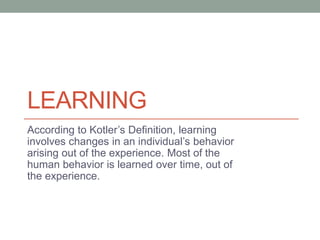M4.pptx
•Als PPTX, PDF herunterladen•
0 gefällt mir•4 views
CONSUMER BEHAVIOUR
Melden
Teilen
Melden
Teilen

Empfohlen
Weitere ähnliche Inhalte
Ähnlich wie M4.pptx
Ähnlich wie M4.pptx (20)
Cb unit-vi (psychological influences on consumer decision making)

Cb unit-vi (psychological influences on consumer decision making)
Consumer Learning the meaning and types in consumer behaviour

Consumer Learning the meaning and types in consumer behaviour
Mehr von MANASA759282
Mehr von MANASA759282 (20)
The relationship bw culture and service quality perception. Based on the Cros...

The relationship bw culture and service quality perception. Based on the Cros...
Group 4_Evolution of Entrprenurial Thought (1).pptx

Group 4_Evolution of Entrprenurial Thought (1).pptx
Group 5_Modern Management Thought- Systems School .pptx

Group 5_Modern Management Thought- Systems School .pptx
Kürzlich hochgeladen
VVVIP Call Girls In Greater Kailash ➡️ Delhi ➡️ 9999965857 🚀 No Advance 24HRS...

VVVIP Call Girls In Greater Kailash ➡️ Delhi ➡️ 9999965857 🚀 No Advance 24HRS...Call Girls In Delhi Whatsup 9873940964 Enjoy Unlimited Pleasure
Mifty kit IN Salmiya (+918133066128) Abortion pills IN Salmiyah Cytotec pills

Mifty kit IN Salmiya (+918133066128) Abortion pills IN Salmiyah Cytotec pillsAbortion pills in Kuwait Cytotec pills in Kuwait
Kürzlich hochgeladen (20)
B.COM Unit – 4 ( CORPORATE SOCIAL RESPONSIBILITY ( CSR ).pptx

B.COM Unit – 4 ( CORPORATE SOCIAL RESPONSIBILITY ( CSR ).pptx
Regression analysis: Simple Linear Regression Multiple Linear Regression

Regression analysis: Simple Linear Regression Multiple Linear Regression
VVVIP Call Girls In Greater Kailash ➡️ Delhi ➡️ 9999965857 🚀 No Advance 24HRS...

VVVIP Call Girls In Greater Kailash ➡️ Delhi ➡️ 9999965857 🚀 No Advance 24HRS...
0183760ssssssssssssssssssssssssssss00101011 (27).pdf

0183760ssssssssssssssssssssssssssss00101011 (27).pdf
7.pdf This presentation captures many uses and the significance of the number...

7.pdf This presentation captures many uses and the significance of the number...
Call Girls Pune Just Call 9907093804 Top Class Call Girl Service Available

Call Girls Pune Just Call 9907093804 Top Class Call Girl Service Available
How to Get Started in Social Media for Art League City

How to Get Started in Social Media for Art League City
Call Girls in Gomti Nagar - 7388211116 - With room Service

Call Girls in Gomti Nagar - 7388211116 - With room Service
Mifty kit IN Salmiya (+918133066128) Abortion pills IN Salmiyah Cytotec pills

Mifty kit IN Salmiya (+918133066128) Abortion pills IN Salmiyah Cytotec pills
Yaroslav Rozhankivskyy: Три складові і три передумови максимальної продуктивн...

Yaroslav Rozhankivskyy: Три складові і три передумови максимальної продуктивн...
👉Chandigarh Call Girls 👉9878799926👉Just Call👉Chandigarh Call Girl In Chandiga...

👉Chandigarh Call Girls 👉9878799926👉Just Call👉Chandigarh Call Girl In Chandiga...
Call Girls In Panjim North Goa 9971646499 Genuine Service

Call Girls In Panjim North Goa 9971646499 Genuine Service
Best VIP Call Girls Noida Sector 40 Call Me: 8448380779

Best VIP Call Girls Noida Sector 40 Call Me: 8448380779
Grateful 7 speech thanking everyone that has helped.pdf

Grateful 7 speech thanking everyone that has helped.pdf
M4.pptx
- 1. LEARNING According to Kotler’s Definition, learning involves changes in an individual’s behavior arising out of the experience. Most of the human behavior is learned over time, out of the experience.
- 2. Elements of Consumer Learning • Motivation • Cues • Response • Reinforcement
- 4. MARKETING APPLICATION OF CLASSICAL CONDITIONING • Repetition • Stimulus Generalization • Stimulus Discrimination
- 6. INSTRUMENTAL CONDITIONING • In Instrumental Conditioning, the stimulus that results in the most satisfactory response is the one that is learned. • In consumer behavior terms, it suggests that consumers learn by trial and error process in which some purchase behaviours results in more favourable outcomes (i.e., rewards) than other purchase behaviours. A favourable experience is “instrumental” in teaching the individual to repeat a specific behavior.
- 8. CONSEQUENCES OF OPERANT CONDITIONING • Positive Reinforcement • Negative Reinforcement • Forgetting and Extinction
- 9. Strategic/Marketing applications of instrumental conditioning • Customer Satisfaction (Reinforcement) • Relationship Marketing • Reward
- 10. Cognitive learning theory: Neo-Pavlovian Model • A considerable amount of learning takes place as a result of consumer thinking and problem solving.
- 12. How Consumers Store, Retain, and Retrieve Information • The structure of memory Sensory store Short-term store Long-term store • Rehearsal and encoding • Information overload • Retention
- 13. MODELING OR OBSERVATIONAL LEARNING: - • “It is a process by which individuals observe the behavior of others, and consequences of such behavior.
- 14. INVOLVEMENT THEORY There are four general CIT categories: • High involvement / emotional • High involvement / rational • Low involvement / emotional • Low involvement / rational